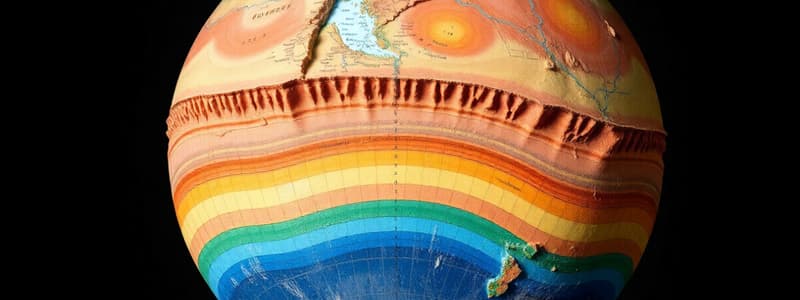Podcast
Questions and Answers
What was a significant consequence of the breakup of Pangaea?
What was a significant consequence of the breakup of Pangaea?
- Increased intertidal habitats
- Development of unique species on isolated continents (correct)
- Harmonization of climates across continents
- Global cooling
What distinguishes macroevolution from microevolution?
What distinguishes macroevolution from microevolution?
- Macroevolution studies genetic variations, while microevolution does not.
- Macroevolution involves large-scale changes over long periods, while microevolution focuses on small-scale changes within populations. (correct)
- Macroevolution occurs only in plants, while microevolution occurs in animals.
- Microevolution is observed over millions of years, whereas macroevolution happens quickly.
Which statement is true regarding natural selection as proposed by Darwin and Wallace?
Which statement is true regarding natural selection as proposed by Darwin and Wallace?
- Only organisms with genetic mutations survive natural selection.
- Traits that enhance survival and reproduction become more common in a population over time. (correct)
- Natural selection leads to identical adaptations in all populations regardless of their environments.
- Natural selection can occur without environmental changes.
What is the primary driver of species extinction in contemporary times?
What is the primary driver of species extinction in contemporary times?
Which of the following consequences is associated with habitat loss?
Which of the following consequences is associated with habitat loss?
Which layer of the Earth is liquid and composed of iron and nickel?
Which layer of the Earth is liquid and composed of iron and nickel?
What type of plate boundary is characterized by plates moving apart?
What type of plate boundary is characterized by plates moving apart?
Which of the following is considered a major cause of mass extinctions?
Which of the following is considered a major cause of mass extinctions?
Which extinction event occurred approximately 65 million years ago?
Which extinction event occurred approximately 65 million years ago?
What evidence supports the theory of plate tectonics through fossil distribution?
What evidence supports the theory of plate tectonics through fossil distribution?
Which of the following processes leads to rapid diversification of species into new ecological niches?
Which of the following processes leads to rapid diversification of species into new ecological niches?
What is the likely cause of the Permian Extinction?
What is the likely cause of the Permian Extinction?
Which type of plate boundary leads to the formation of mountain ranges?
Which type of plate boundary leads to the formation of mountain ranges?
Flashcards
Continental Drift
Continental Drift
The process where continents move and collide, creating supercontinents like Pangaea and later breaking apart, leading to the isolation of continents and the development of new species.
Macroevolution
Macroevolution
Large-scale evolutionary changes that occur over millions of years, resulting in new species and major groups of organisms.
Natural Selection
Natural Selection
The process by which organisms with traits that help them better survive and reproduce in their environment are more likely to pass those traits to their offspring.
Habitat Loss
Habitat Loss
Signup and view all the flashcards
Microevolution
Microevolution
Signup and view all the flashcards
What is the Earth's crust?
What is the Earth's crust?
Signup and view all the flashcards
What is the Earth's mantle?
What is the Earth's mantle?
Signup and view all the flashcards
What is the Earth's outer core?
What is the Earth's outer core?
Signup and view all the flashcards
What is the Earth's inner core?
What is the Earth's inner core?
Signup and view all the flashcards
What are continental plates?
What are continental plates?
Signup and view all the flashcards
What are plate boundaries?
What are plate boundaries?
Signup and view all the flashcards
What is a mass extinction?
What is a mass extinction?
Signup and view all the flashcards
What is adaptive radiation?
What is adaptive radiation?
Signup and view all the flashcards
Study Notes
Earth's Structure and Plate Tectonics
- Earth's structure has layers including the crust, mantle, outer core, and inner core.
- Major continental plates are identified on a global map, illustrating their movement.
Plate Tectonics Processes
- Subduction: Dense seafloor crust pushes under less dense continental crust, returning seafloor crust to the mantle. This process occurs at ocean trenches.
- Seafloor Spreading: New seafloor crust forms through eruptions at mid-ocean ridges where plates spread apart.
Plate Boundaries
- A map illustrates different types of plate boundaries (convergent, divergent, transform) including major plates like the North American, Eurasian, African, and Pacific plates.
Plate Tectonics and Mass Extinctions
- Climate changes, volcanic eruptions, diseases, plant evolution, environmental changes (ocean chemistry), and global marine regressions/transgressions are among the contributing causes of mass extinctions.
- Asteroid impacts have also been implicated as a cause of mass extinctions. This is not definitively the only cause.
Extinction
- Extinction is the disappearance of all individuals of a species or group of species.
- Extinction is a natural part of the evolutionary process.
- Extinction rates vary significantly throughout geological time.
Mass Extinction Events
- Specific mass extinction events, like the Ordovician, Devonian, Permian, Triassic, and K-T (Cretaceous-Paleogene) events are detailed, outlining their time periods, possible causes, and effects.
Consequences of Continental Drift
- Formation of Pangaea (a supercontinent) significantly impacted habitats, creating climate changes, and influencing evolution.
Adaptive Radiations
- Adaptive radiation occurs when organisms colonize new environments with little competition.
- The Hawaiian Islands are an example of a showcase for adaptive radiation.
- Different species characteristics can be related to distinct environments.
Evolutionary Relationships
- Evolutionary relationships between species (e.g., reptile, bird) and the importance of fossils for understanding transitional forms are illustrated. A cladistic tree shows relationships. The diagram shows a tree of life illustrating evolutionary relationships.
Microevolution
- Microevolution involves relatively small-scale changes in allele frequencies within populations or species.
- Evolution in characteristics like size, color, or resistance to factors like pesticides or diseases can be examples of microevolution.
- House sparrows in different geographic locations demonstrate microevolution, influenced by environmental factors.
Macroevolution
- Macroevolution is larger-scale evolutionary change.
- It includes the appearance of new species, significant changes in body forms, and the evolution of one species to another (e.g., dinosaurs evolving into birds.)
Darwin, Wallace and Natural Selection
- Darwin and Wallace independently proposed the theory of natural selection as a driver of evolution.
- Natural selection relates to competition for resources, survival, traits, and reproduction.
The Cretaceous Plant Problem
- Differences in plant life between the Cretaceous and the Tertiary periods are addressed.
Ocean Acidification
- Increased atmospheric carbon dioxide lowers ocean pH values.
Increasing Carbon Dioxide and Temperatures
- Increasing CO2 levels correlate with rising global temperatures. Data supports a relationship.
Biological Annihilation
- A global study identifies catastrophic declines in species populations worldwide over the past two decades. This is not related to geological time scales discussed in previous sections.
- Examples like declining populations of cheetahs, giraffes, lions, and orangutans are cited, along with causes for population decline.
Human-Caused Habitat Loss
- Human activities are shown to drive species towards extinction.
- Deforestation and habitat loss are examples of human-caused factors.
- Data shows the decline in habitat over time.
Evolutionary History of Mammals
- An ancestral mammal lineage is displayed.
- Different mammalian groups(monotremes, marsupials, placentals) and their divergence times are shown.
Microevolution and Macroevolution
- The notes differentiate between microevolution and macroevolution.
- Examples of both concepts are displayed.
K-T Impactor
- Details of the asteroid impact in the Yucatan Peninsula & its potential connection to mass extinction are examined. Size, time, and force are discussed as a possible cause of the extinction of dinosaurs.
Tiger Loss
- Data displays the shrinking historical range of the tiger (panthera tigris). Loss of habitat.
Studying That Suits You
Use AI to generate personalized quizzes and flashcards to suit your learning preferences.



